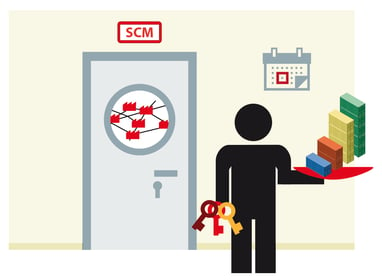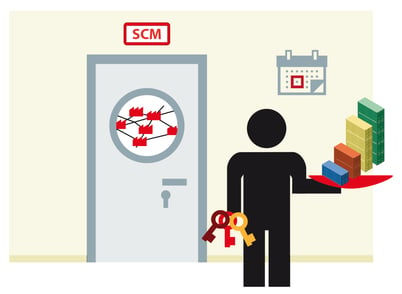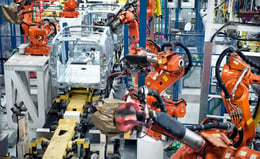What Are the Keys to Supply Chain Visibility?
Jesse Kelber - September 12, 2019

 A friend of mine once told me he wouldn’t eat in any restaurant where he couldn’t see into the kitchen. What he was getting at is that you never know what’s going on behind closed doors, and he doesn’t want to eat anything he can’t see being prepared. Now imagine your supply chain is that restaurant kitchen, do you know what’s going on behind the closed doors of your manufacturing, business, and logistics processes? Visibility into the end-to-end supply chain is something that every production planner and logistics manager wants, yet few seem to achieve. And like that restaurant kitchen, what’s lurking behind the scenes can impact your customer’s satisfaction and therefore your bottom line.
A friend of mine once told me he wouldn’t eat in any restaurant where he couldn’t see into the kitchen. What he was getting at is that you never know what’s going on behind closed doors, and he doesn’t want to eat anything he can’t see being prepared. Now imagine your supply chain is that restaurant kitchen, do you know what’s going on behind the closed doors of your manufacturing, business, and logistics processes? Visibility into the end-to-end supply chain is something that every production planner and logistics manager wants, yet few seem to achieve. And like that restaurant kitchen, what’s lurking behind the scenes can impact your customer’s satisfaction and therefore your bottom line.
And also like that restaurant kitchen, what goes on behind closed doors needs to be brought into the light of day before you can begin to sort out the variations, discrepancies, and other assorted issues on the path to full transparency. Of course, not all of your supply chain is within your control. Restaurants take delivery of raw food materials from a variety of distributors, and your factories take delivery of raw materials from around the globe. You can only affect the segments of the chain that fall under your purview. Transparency is a means to an end for your supply chain. Specifically, it’s a means of ensuring production efficiency, delivery timeliness, and keeping your customers thrilled with your service. The more visibility you achieve, the closer you get to a full Industry 4.0 implementation. Let’s get you started on your journey into supply chain transparency. Below are some tips we’ve compiled to help you on your way.
Create a Strategy for Iterative Implementation
Before you achieve full transparency of the entire supply chain, you need to gain visibility into one piece of it. And the first step to achieving that goal is ensuring that your back-end systems are up to the task ahead. You wouldn’t cut a window into the kitchen if your cooks were still cutting corners, would you? Set goals for your supply chain project, make sure they’re SMART, and be sure to have an accountability partner somewhere in your organization who can help keep things on track. Accomplishing this work before beginning an Industry 4.0 related rollout will help ensure things stay on course and will allow you to continue working iteratively. Check your work as you go by analyzing established metrics, measuring your results against KPIs, and checking in with your people on the ground to be sure they’re keeping up and are happy with the changes being made.
Adopt Key Industry 4.0 Technologies
Once your systems and workforce are ready, it’s time to implement new, emerging technologies. IoT, RFID, machine learning, and advanced analytics are all part and parcel of the new world of supply chain management. It pays to know what your partners are using at this stage, so you can ensure ongoing compatibility and reassure them at the same time that you’re doing what’s needed to stay on top of technology developments. If you don’t keep up with your suppliers and customers alike, you risk alienating them and losing them to competitors who have adapted and adopted more quickly. Since visibility is the name of the game here, starting with the monitoring capabilities of IoT sensors on your factory floor and the analytics to parse the data they generate is a great first step. Then, continue iterating by implementing one solution at a time, ensuring integration with your existing infrastructure as you go.
Maintain Documentation
Another benefit of the iterative approach to attaining supply chain visibility is that it allows you the time and resources to document every step you take along the way. And this gets you closer to that final goal of total transparency because now, no matter who in the company needs to know what specific information, they can find it. Aim for what’s called a Single Source Of Truth, or SSOT. This is essentially a data repository; it can be housed on-site on a server at the head office, or in a cloud-based storage center of your choosing. The key is that it has gated access that you can grant to stakeholders across the company, and even within partner organizations as appropriate. The kicker about a properly configured SSOT is that everyone benefits. Now, when a customer calls support about an order, every one of your CSRs will know where to look for the updated logistics information they need to keep that customer happy.
Adopt a Postmodern ERP Mindset
If there is one single piece of this puzzle that we would say is absolutely critical to end-to-end visibility of your supply chain, it’s a complete integration of all IT systems. Data silos must be rooted out and eliminated, with all data moved to a central location (SSOT). The ultimate goal of each item on this list is actually seen in this mindset itself. Since all industry 4.0 technology is targeted at giving you visibility into the processes they govern, the more pieces you deploy, the closer you get to full adoption of a postmodern ERP, where every piece is connected to every other piece and they all communicate in real-time. It helps to step back every once in a while during a project like this and look at your systems from this ERP standpoint.
Are the systems you’re putting in place going to eliminate silos? Are they going to work seamlessly with each other, and with your partner's systems? And are they going to scale as you continue to grow the company? If the answers are yes, congratulations, you’re putting in place a postmodern ERP that will give you unprecedented access and visibility into your supply chain. This level of supply chain visibility is a gigantic undertaking, not to be approached lightly. There are steps and processes to go through that will help ensure the outcome is what you’re after while helping maintain your value chain relationships in the process. And just like that commercial kitchen, pretty soon you’ll like what you see and feel secure in the output you’re giving your customers.
LATEST POSTS
- Understand Circular Economy in The Manufacturing Industry
- How Can Industry 4.0 IT Integration Be Achieved Smoothly?
- The Significance of Order Sequencing in Discrete Manufacturing
- How to improve your Supply Chain Management: The Power of Control Towers
- Optimizing Human Resource Scheduling in Manufacturing: A Technological Approach



